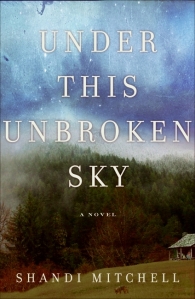
There is a black and white photograph of a family: a man, woman and five children. Scrawled on the back, in tight archaic script, are the words: Willow Creek, Alberta, 1933. This will be their only photograph together ...Thus we are introduced to the Mykolayenkos, a family of Ukrainian immigrants, through a faded image. They escaped Communist oppression in their native country and are working relentlessly to eke out an existence in the harsh Northern Canadian prairie. In the introduction, readers are told that one of the people in the photograph will soon die, and two people -- not in the picture -- will be murdered. Throughout the story, watching this family's relentless struggles, I was waiting for the promised tragedy to strike. This contributed to a sense of suspense and foreboding that escalated throughout the story, ending with a heart-breaking climax.
This novel was crafted in an unusual style, a present tense narrative without dialogue. At first the use of present tense in a historical novel felt odd. But combined with the wealth of descriptive detail woven into the book, it gave the story a compelling sense of immediacy. I felt myself living on the prairie, enduring the brutal cold and relentless snow, seeing the stunning spring fields, and feeling a humid, bug-infested tundra summer. I also felt I was a part of the toil of sowing and harvesting wheat, gardening, and other quotidian tasks of life on a farm and of this family's ongoing struggle to survive.
The characters in the novel are also compelling. We see Teodore, sometimes harsh but hard-working, honorable, and passionately devoted to his family. His sister Anna, once beautiful and confident, is unraveling and unable to love her children. She feels trapped in her life and is obsessed with the coyotes who prowl the prairie at night, wild and free. Anna's husband Stefan, a former military officer, is the most despicable character in the book; he actually infuriated me. Teodore's wife Maria is incredibly resilient and loving. Each of the children has unique qualities and individual ways of responding to the hardships they face. My favorite is Leysa, Anna's physically disabled daughter. Her mother is unable to fully accept her because of her "defect," but her aunt Maria always finds a role for her in the family, never letting her feel that she has any less to contribute than anyone else. Leysa seemed so real to me that at times her story was painful to read.
In addition to a vividly described setting and vibrant characters, this book brings together many historical threads, including the changes in Eastern Europe wrought by Communism, the Great Depression and Prohibition. It also touches on prejudice faced by European immigrants in North America, where they were considered inferior to the English, and on the limitations imposed by gender roles.
While Under This Unbroken Sky is not a fun, light read, I thoroughly enjoyed the beautiful writing, well-paced suspense, unforgettable characters and wealth of themes explored. I highly recommend it to historical fiction lovers.
Read More Reviews: Rhapsody in Books Weblog; The Indextrious Reader
Rating: 4
| 5- Cherished Favorite | 4 - Keep in My Library | 3 - Good Read | 2 - Meh | 1 - Definitely Not For Me |

No comments:
Post a Comment
Hello, and thank you for taking the time to share your thoughts -- reader comments make this blogging gig worthwhile. :-) Due to excessive spam, we are now moderating all comments. Like that dude in the Monty Python skit, we just Don't ... Like ... Spam. I will try to post and respond to your comments as quickly as possibly.